WIE Orientation: Across Many Years, Ameliorations, It’s Still the Best Ticket in Town for Fostering Connections Among Engineering Women
“But at the end of those orientation days, they feel very comfortable on campus, too—that they belong together...They have this moment where they're meeting each other, and that's their network. – Dean Sue Larson
August 31, 2020

Aerospace Engineering freshman enjoys WIE Orientation via Zoom from her dorm room.
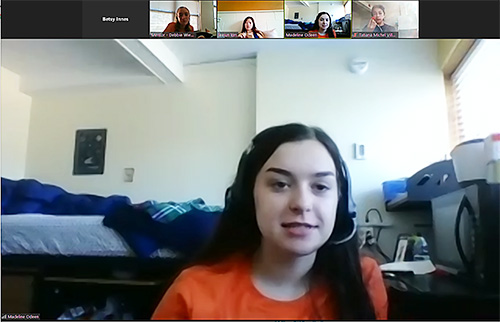
Freshman Madeline Odeen shares during one of Aerospace Engneering's Zoom sessions.
Connections. This was the message 308 incoming female Engineering Freshmen received during the 18th WIE (Women in Engineering) Orientation, the fall 2020 semester kickoff designed to connect incoming freshmen with resources and to foster relationships. The idea behind the August 19th and 20th event was to arm freshmen with the wisdom of upperclassmen, who had been in their shoes just a few short years ago; introduce them to both advisors and faculty in their departments to whom they could go for advice; and to foster relationship building among fellow freshmen in their departments and even in their courses.
In its 18th year, Orientation, which was sponsored by Brian and Sophie Leung, Caterpillar, Abbott, and Texas Instruments, has changed since its inception back in 2003. Begun by Engineering Assistant Dean Larson, it was designed to help the women in Engineering find one another. “So the idea was if we bring them together, they'll see that, yes, there are people who look like them in engineering, and they'll get to know one another. And once they know one another, then they're good, right? They have a community. It won't matter if they're outnumbered or not, because they have a group—they have a place where they belong.”
In some ways, Orientation has come full circle. The focus of the very first one was connections. “So at that time,” Larson recalls, “it was really just dump your stuff in your dorm room, get on the bus, and go to Allerton.” Claiming she didn't want campus to distract them, she says, “I wanted them just to focus on making connections with one another.” So they did workshops out there, the challenge course, hikes, “and they just got to know one another.”
Larson says one popular WIE Orientation tradition has been that students get to move in before school starts. “That was not my original idea,” Larson says. “That was kind of just fortuitous!” Her original idea was to do it over the Labor Day weekend because students wouldn’t have much to do. However, the 4H camp was already booked, but could do it right before school started.

During the 2012 WIE Camp, a camper negotiates the "Tire Traverse" station on the challenge course.
“But really, that worked out so much better because this was the first people students got to meet—each other,” she acknowledges.
WIE Orientation has changed a lot over the last 18 years. For instance, it’s grown from 30 participants in the original pilot, to 308 this year. It’s changed names…from WIE Camp, to WIE Orientation, to being affectionately dubbed “Double-O” (Online Orientation) by this year’s leadership.
It’s also changed venues/programming. The very first event was at Allerton Park’s 4H Memorial Camp. When this reporter first covered it back in 2012, it began on campus then adjourned to Allerton for s’mores around a campfire the first night then fun relationship- and team-building exercises like climbing a wall or using the “Tarzan” rope swing or Tire Traverse on the park’s Challenge Course. A few years later, for financial reasons (the university no longer gave WIE an early-move-in discount) it moved to campus only, but still before classes started, so these were the first students female engineering freshmen met. Activities featured fun face-to-face, informational and relationship-building activities like a scavenger hunt to familiarize students with campus, and a mini Career Fair, where students could meet industry recruiters up close. However this year (due to COVID-19), it was entirely online, except for a smoothie break mentors and their teams, wearing facemasks, enjoyed in various locations across campus on the afternoon of the 20th.
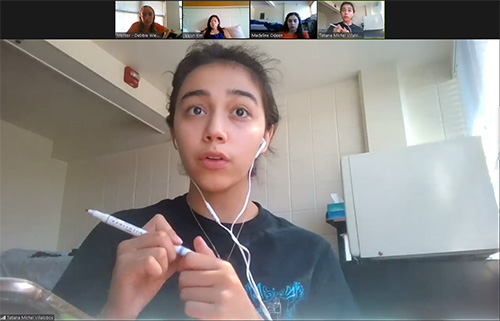
Aerospace Engineering freshman Tatiana Villalobos shares via Zoom during a breakout session.
WIE Orientation has also gotten shorter over the years. The very first one was two nights at the 4H Camp. But Larson admits, “We learned things from year to year. One was that two nights at Allerton was too much for a big group.” Plus, as Orientation grew and more freshmen starting attending, she discovered that, “Moving into college dorms is emotionally and physically exhausting. And the last thing you want to do is move into your dorm room, say goodbye to your parents, and then leave again.” (Not to mention the mess you’d still be facing once you got back.)
It’s also gotten shorter in order to accommodate more students. For example, students often had conflicts due to other orientation programs, thus were forced to choose between the two). So, somewhat similar to last year’s Orientation, this year’s was a shortened version, with organized activities beginning on Wednesday evening and running through early Thursday afternoon. (Groups were free to gather for smoothies, of course, later that afternoon.)
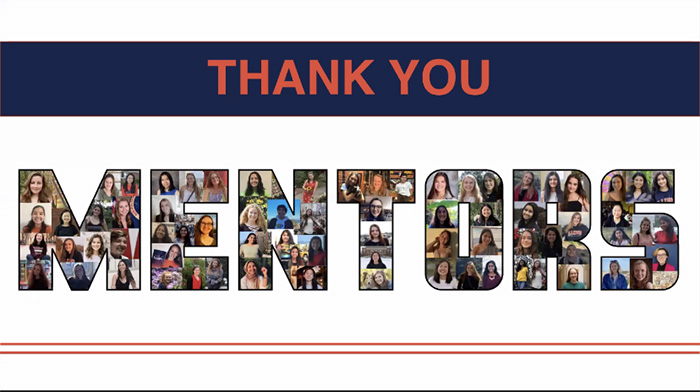
A group shot of the 72 mentors who volunteered to share their wisdom with the incoming engineering freshmen.
Also, most Orientations also featured special speakers, and sometimes a keynote—usually former students using their engineering skills acquired at Illinois out in the real world to make a difference. Some featured speakers have included Ann Zuzuly and Val Laguna. This year, however, featured no special speakers: Dean Rashid Bashir addressed the girls and welcomed them to Engineering at Illinois.
Probably the pivotal piece in this year’s orientation was the small groups, led by the mentors, the 72 female engineering students who had volunteered to show freshmen the ropes. Small groups were comprised of between four and eight people per mentor. The extremely apropos group size was determined by…you guessed it, Zoom! “That way everyone's picture would look big,” admits Wolters. “So between four and eight people in each room, that way they can see each other and they don't have to go through multiple screens to look at people.”
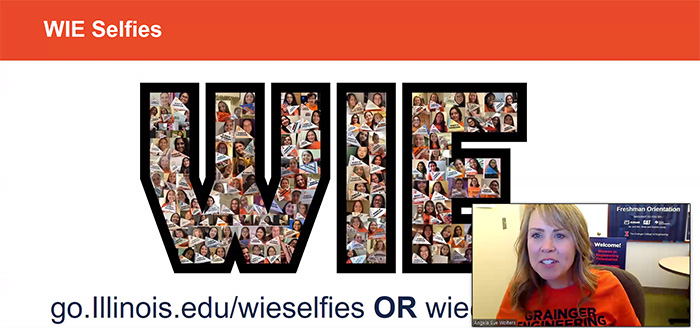
Angie Wolters (bottom right) shares the group photo of freshmen selfies taken with the Illinois pendant each made.
A “small but powerful” amount of time during most Orientations has been devoted to a group photo, designed to convey to the freshmen that “We’re all in this together!” When they see that huge group of women, shoulder to shoulder, they understand that they’re not the only girl in engineering, and there are myriad connections they can make—academically, socially, and relationally. This year was no different. However, rather than trooping to a specific place on campus and arranging themselves in some semblance of order, the group photo was done virtually, and featured freshman showing off Illinois pendants featuring Quin that they’d made using materials mailed to them ahead of time.
(As an aside, the swag bag freshmen received featured several relevant items: an orange WIE Orientation t-shirt; a pendant featuring Quin (the Quintessential Engineer, the only statue of a female engineer on campus), plus fun goodies to decorate it; a WIE connection card; markers; essential Illinois swag, such as laptop stickers; plus orange and blue paper to make their paper hearts for Dean Larson's guest lecture.)
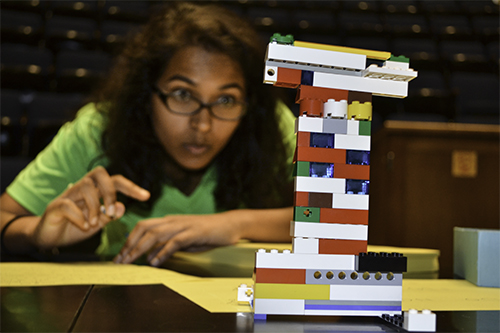
During the 2015 WIE Orientation, an Engineering freshman competes in a Lego team-building activity.
Many Orientations featured activities designed to familiarize students with campus, apprise them of how courses and the University work, and to foster connections with both resources and people. For instance, some Orientations featured a Chemistry demo, with professors sharing protocols and tips about how to succeed on campus, such as take advantage of office hours, and don’t forget to sleep and shower! A Lego Team-Building Exercise taught students this key principle: engineering involves teamwork. A scavenger hunt or Resource Exploration Tour would help students get familiar with buildings on campus and where certain resources are located. Plus, breakout sessions apprised students of important topics: the campus bus system, and key Engineering offices such as the Undergraduate Office, Engineering Career Services, etc.
In lieu of those non-social-distancing activities, leadership developed lesson guides for this year’s virtual program, designed to ensure that mentors, who would be sharing the bulk of the info, made sure to address needed information. They even had a (virtual, of course) training session for mentors.
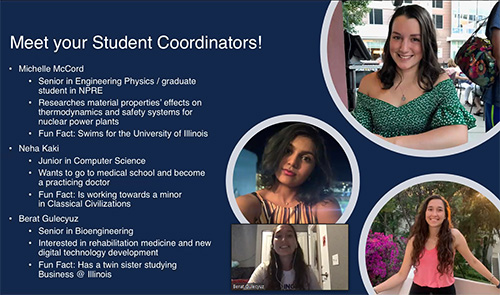
Berat Gulecyuz (bottom left rectangle), one of this year's student coordinators, introduces herself during Wednesday evening's introductory session.
Regarding paring down programming, student coordinator Michelle McCord discloses, “We talked a lot about where we wanted to put our emphasis for connections this year. And we know that not only are we virtual, but almost our entire school year is virtual. And especially for freshmen, the majority of their courses are online, and they're not going to have as many opportunities to meet people in the same way that the rest of us did as freshmen.”
Because they thought it important to focus orientation more so about connecting, the leadership team eliminated some informational pieces people had found helpful in years past, such as studying abroad, internships, and the mock career fair with different companies.
“But we saw that our role this year really fell into helping people form community in a space where community looks a little bit harder to form,” adds McCord. “But nobody does well their freshman year if they have nobody to talk to. So we want to make sure they form friendships and find study groups and can really connect with their peers.”
Adds Wolters: “Orientation has always been about the community building and the chance for them to meet each other. We've just had to be very intentional about it so that we can make sure it happens in Zoom, and so we've focused more on that piece.”
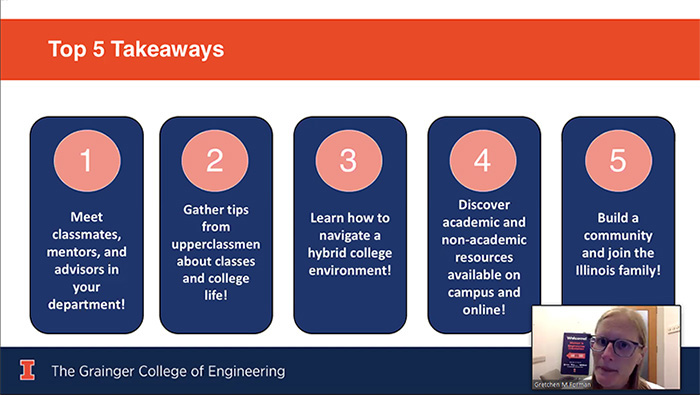
Gretchen Forman (bottom right) shares the top 5 things Orientation leadership hoped the freshmen would take away from the event.
In fact, the leadership team zeroed in on the five most important things the freshmen should glean from Orientation (see the "Top Five Takeaways" slide to the right), and structured Orientation accordingly. So this year’s program went something like this. A kickoff webinar for the first 15 minutes on Wednesday evening introduced freshmen to Women in Engineering and the Orientation staff: Angie Wolters, WIE Director; Gretchen Forman, Program Coordinator of the Illinois Engineering First-Year Experience (IEFX); and Carolyn Hughes, Engineering Office Support Associate. Next, student coordinators Michelle McCord, Neha Kaki, and Berat Gulecyuz were introduced. Additional info presented was intended to help them learn a little bit about the college, discover key offices and people they should know about, plus give them some perspective.
Next, freshmen navigated to Zoom breakout rooms based on their major. As in years past, a lead departmental mentor fostered connections and shared content. Then additional Zoom breakout rooms functioned in the same way as small, in-person mentor groups in the past. In fact, the backbone of the fall 2020 Orientation was mentors meeting with mentees in breakout rooms.
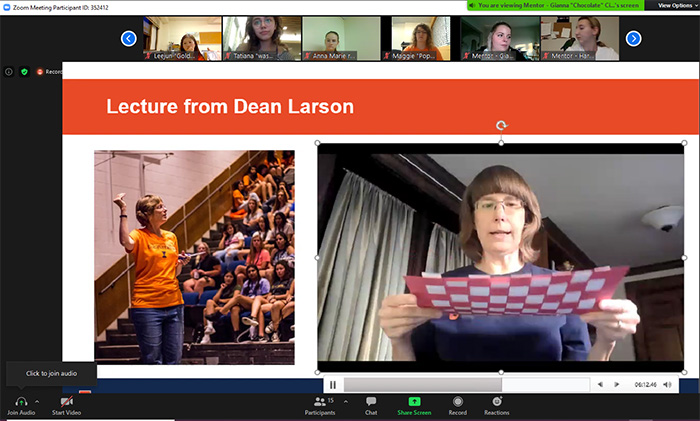
Dean Sue Larson gives her video lecture on how to weave a heart, a hands-on activity designed to introduce freshmen to lectures, discussion groups, teamwork, etc.
Of course, as in recent years, Dean Sue Larson gave her “Heart Basket Weaving 101” mock lecture to expose students to what a lecture might be like. In fact, it was a recorded video lecture, similar to what students will experience this semester. Following the lecture, freshmen wove heart baskets, getting a little help from their friends, since one student might have picked up one point, while another understood a different aspect. This portion of the activity was designed to plant the notion that connections with fellow students might be required in order to get the most out of a course and/or to complete a task.
Regarding the effectiveness of the mock lecture, Aerospace Engineering freshman Leejun Kim says, "My favorite event was when we were able to receive a mock lecture as well as mock homework. The assignment with the construction paper helped me to remember to always think outside the box and not to be afraid to ask my peers for help."
Next the department leads shared some crucial information: “What's really the difference between lectures and discussion sections, how to succeed in both of them, especially in an online format; and the best ways to engage and get involved,” Wolters explains.
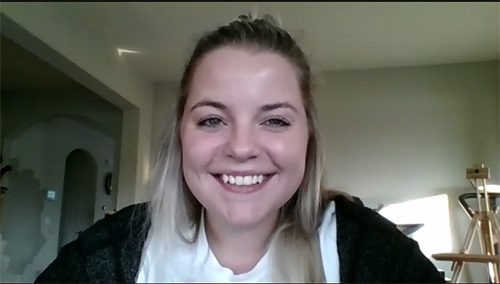
Gianna Ciaglia interacts with Aerospace freshmen during a Zoom session.
Back in their breakout rooms, the next activity used connection cards they’d been mailed. Wolters explains that the cards were “about creating conversations that matter this summer.” She admits that Orientation leadership had high hopes that the cards would take the conversations from superficial to deeper sharing. “We're trying to break down the Zoom barriers with these cards,” she acknowledges.
“So it's about creating conversations that are more than, ‘Hi, I'm Angie!’ I grew up here,” she continues. “This is where I went to high school and my major is this. Right? It's talking about what you're grateful for. It's ‘What's the best, worst, or funniest job you ever had?’ or ‘What would a close friend say is your best character trait?’”
There were 60 questions, so all the girls got different ones. The plan was “Having them share and then really connect, because Zoom is hard to make some of those connections,” admits Wolters. “But if we're talking about things that are deeper than where they went to school, it's easier for them to start talking and finding ways they connect with other people.”
Wolters divulges that her favorite question was, “What trait do you look for in a friendship?” Imagining a scenario where they talk about that question in their small group, she envisions a girl telling herself, “Oh, I could be friends with that girl. Those are the things I value too!”
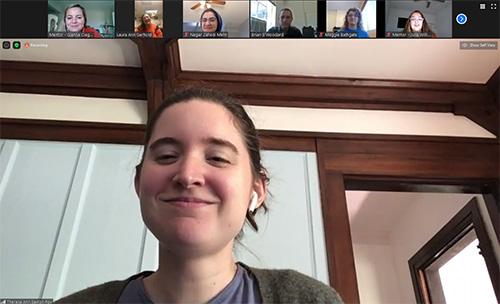
Assistant Professor Theresa Ann Saxton-Fox shares with freshmen and mentors during Aerospace Engineering's Departmental Zoom on Thursday at noon.
The remainder of the activities stressed other connections important for freshmen to make: details about RSOs (Registered Student organizations), including several engineering RSOs, as well as non-engineering ones. They also shared about both in person and online academic resources that are available.
In years past, a key event was the departmental luncheon, where freshmen could meet their department head, different professors in their department, plus advisors. While this year’s version was sans lunch, the virtual version held via Zoom on Thursday over the noon hour introduced freshmen to key folks in their departments, including advisors and faculty who teach large freshman courses.
For instance, in the Aerospace Engineering breakout room, freshmen met Laura Gerhold, Chief Advisor for Aerospace Engineering, who, if the Aero WIE mentors who sang her praises are accurate, has been a cheerleader, chief confidante, miracle worker, and comforter for most of the Aerospace students. Gerhold shares a bit of advice for the freshmen…all of us, actually:
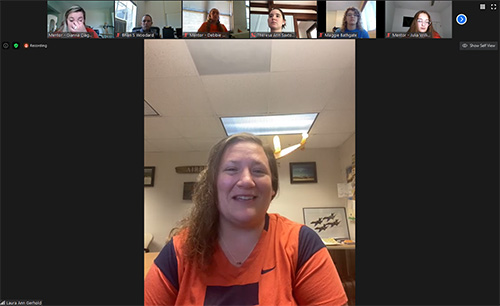
Chief Advisor, Laura Gerhold, shares during Aerospace Engineering's Thursday Zoom session.
“For the Fall 2020 term, my advice is to keep these words in mind each and every day: patience, flexibility, grace, and kindness. We are all going to need to practice patience, as this is a new experience for everyone: students, faculty, staff, and administrators. Changes will occur at a higher rate than ever before, so we all need to be flexible and realize that plans may change, and it will be okay. Everyone is bringing their own challenges and experiences to the semester. Remember to give everyone you interact with grace because they are trying their best given their individual situations. Finally, even in the most frustrating situations, try to act and respond with kindness. While Fall 2020 may not be a "typical" term, together we can make it a meaningful and fantastic experience. Do not hesitate to ask for help and remember—we are all one Illini family!”
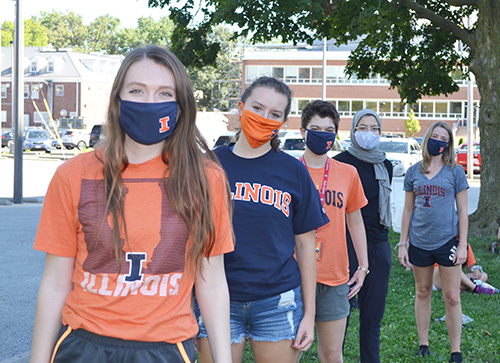
A mentor and her mentees at one of the Sweet Treat stops.
The event’s only in-person activity was on Thursday afternoon. After Orientation officially ended, participants experienced another long-standing WIE Orientation tradition: a sweet treat break. This year’s optional "Sweet Treat" activity occurred in a number of places across campus where freshmen and their mentors gathered to enjoy smoothies (wearing facemasks, of course, and practicing social distancing), make new friends, and meet students outside of their department.
One person who particularly appreciated the "Sweet Treat" activity was mentor Debbie Wiegand. The Aerospace Engineering senior, who’s going into her final semester and is focusing on aircraft, says, “It gave me a chance to meet women from other majors and give them a new perspective on college.”
This is Wiegand's fourth year serving as a WIE Orientation mentor. Acknowledging that mentors are typically the first upperclassmen new students meet, she says she's enjoyed getting to meet incoming freshmen.
“So it is exciting to be the first to show them around campus and help them make connections to their peers,” she admits.
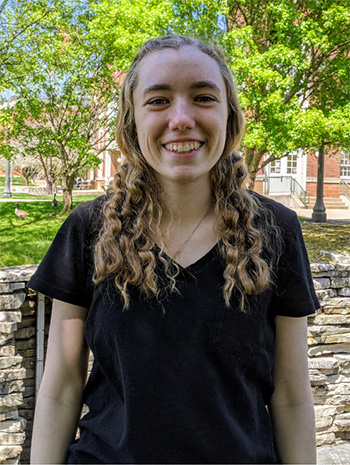
Aerospace Engineering mentor Debbie Wiegand. (Image courtesy of Debbie Wiegand.)
Wiegand participated as a mentor because of the impact Orientation had on her as a freshman. “I really enjoyed the personal touch WIE gives to Orientation,” she says, adding that other freshman orientation events make it hard to meet people because they're mostly large groups of students.
“WIE puts an emphasis on keeping groups small to facilitate meaningful conversions and connections,” she explains. “Some of the people I met during orientation are still people I am friends with now. I was able to meet people who were in my classes, so when I showed up on the first day, I already knew people; it helped make the transition into college easier.”
Regarding this year’s Zoom format, Wiegand says, “I enjoyed the time I got to spend in a breakout room with just a few of the women where I was able to answer questions and talk to them about what to expect this upcoming school year.”
Aerospace Engineering freshman Leejun Kim who arrived on campus from Closter, New Jersey, reports that she attended WIE Orientation in order to "meet new people who are also majoring in the same area as me, and learn more about engineering as a whole."
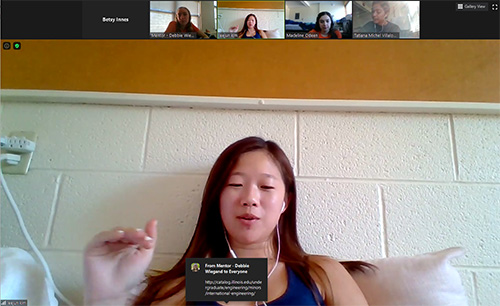
Freshman Leejun Kim asks a question during one of Aerospace's Zoom sessions.
Kim shares how Orientation impacted her: "I was able to make new connections with people in my grade, upperclassmen, and the professors. I was also able to learn more about different student organizations that I can join to expand my learning."
Another mentor, Harriet Hunt, a junior in Aerospace with a focus on computer science, also chose to be a mentor because of the impact Orientation had on her during her time at Illinois.
“My freshman year,” she explains, “I had a really great mentor who helped me so much, and I wanted to be able to do the same for this year's freshmen. Orientation was the reason I decided to join Illinois Space Society and met my current best friend, so it is still positively impacting me.”
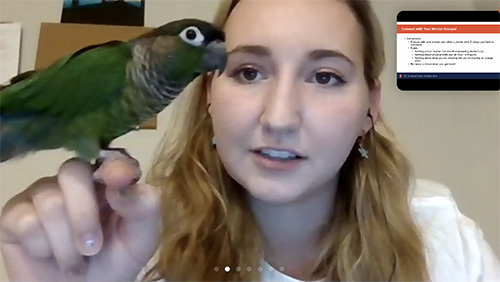
Aerospace Engineering mentor Harriet Hunt (along with her bird, Charlie) interacts with her freshman mentees via Zoom.
Hunt’s favorite part of this year's Orientation was: “That so many people showed up despite it being online. I was excited that they were still actively participating and able to ask questions with the ‘new format.’”
Another mentor, fifth year Aerospace senior, Gianna Ciaglia, on track to graduate in May 2021, says she’s served as a mentor for the last two years because Orientation made a significant difference for her as a freshman…and beyond.
In fact, she says she actually ended up seeing her two Aerospace mentors, Katie Carroll and Sarah Leggett, practically every day of undergrad from then on, both as friends and professionally. “So they gave me a really awesome friendship, that connection to my major. And they're really good friends of mine on top of being an actual professional asset to me as well. So they're really near and dear friends to me nowadays, and it really got me acclimated to Aerospace as I moved there.
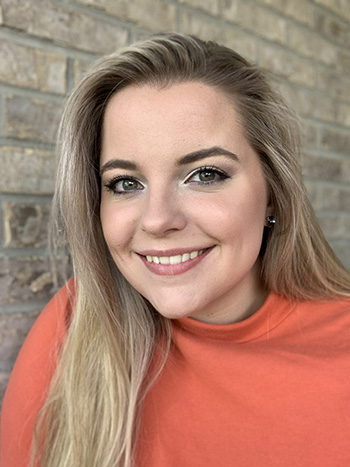
Aerospace Engineering Lead Mentor Gianna Ciaglia. (Image courtesy of Gianna Ciaglia.)
Admitting that while mentorship is a lot of extra work, Ciaglia wanted to be a mentor because of the impact both her WIE Orientation mentors and the relationships she made had on her time at Illinois. As a freshman, she moved from Colorado to Illinois. “I was so afraid about not having any friends,” she admits. “And it was just all very new to me, and I was so nervous about picking up my whole life and moving.”
But then, on top of meeting her mentors, she also met two people who ended up becoming her best friends. “They both have been my roommates up to now. So they became my support system, and the reason why I feel I've been very successful in Aerospace at this point. And just to be that kind of friend and that connection for these freshmen as they walk in, that's what I want to give back to them—it's really awesome connections and things I gained from it.”
Regarding the difficulty of connecting virtually instead of face to face, Ciaglia claims, “I know it feels so different in a virtual world, but it's also been good because there's a lot of applications and things like Group Me and Zoom where, if you take the initiative, you can definitely still make those connections. But it does put a little more emphasis on the person wanting to do that.”
Despite the differences over the years, Larson believes WIE Orientation is still having the impact she hoped for when she began the event: “But at the end of that those orientation days, they feel very comfortable on campus, too—that they belong together. They belong together. They blend on campus. They have this moment where they're meeting each other. They're not just meeting the people in their dorms or the people in their classes, they're meeting each other, and that's their network. And that's been the thing that, to me has becien a big success with the camp, is that I wanted students to meet somebody at camp that they would know four years later.”
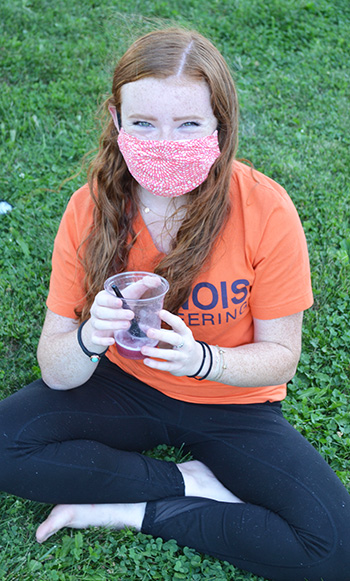
Illinois freshman Erika Jaszka enjoying a smoothie during the in-person Sweet Treat meet-up on Thursday afternoon.
Story and photos by Elizabeth Innes, Communications Specialist, I-STEM Education Initiative
More: Engineering, WIE, Women in STEM, 2020
For additional I-STEM articles about WIE Orientation, see:
- Fall 2019 WIE Orientation Introduces Engineering Freshmen Women to a Support System, Possibly Life-Long Friends
- Freshman Women in Engineering Get Ahead of the Curve At WIE Orientation
- Engineering Freshman Women Get Familiar With Campus, Learn About Illinois Resources, and Build Community at WIE Orientation
- Mariano & Pace Encourage Female Engineering Students: "You Too Can Succeed!"
- At WIE Orientation, Engineering Freshman Women Experience Campus, Build Community
- Cindy and Stephanie Richartz—Keeping It in the Illinois Engineering Family
- WIE Orientation 2015 Shows Female Engineering Freshmen the Ropes
- WIE Camp 2014: Creating Community for Female Engineering Students
- Women in Engineering Camp Facilitates Relationship Building
- From WIE Camp to Seniors: Two Future Engineers Credit Illinois' Community of Support
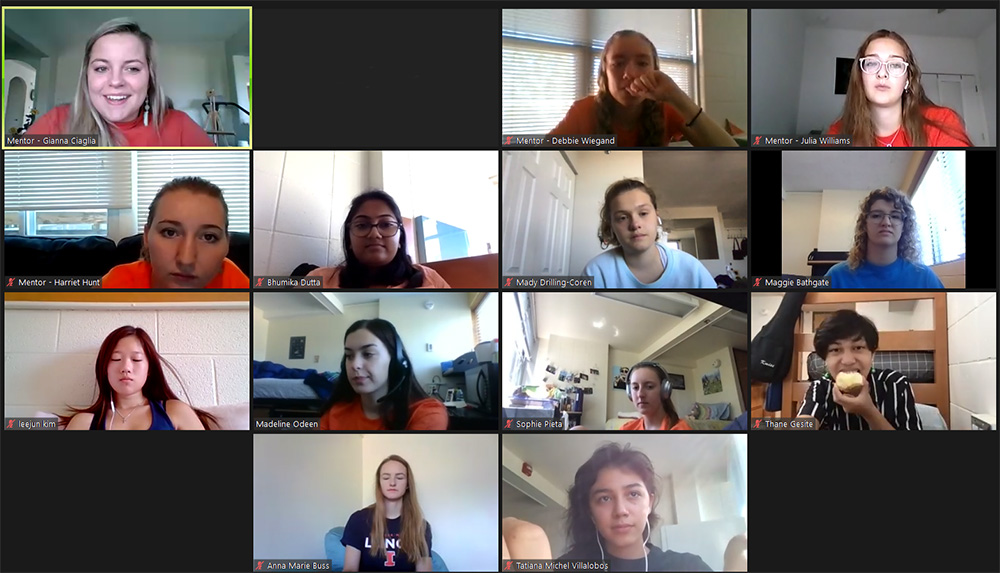 The Aerospace Engineering breakout Zoom during WIE Orientation.
The Aerospace Engineering breakout Zoom during WIE Orientation.












.jpg)
















